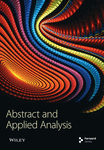Approximation by q-Post-Widder Operators Based on a New Parameter
Abstract
The purpose of this paper is to introduce q-Post–Widder operators based on a new parameter and study their approximation properties. The moments and central moments are investigated. And some local approximation properties of these operators by means of modulus of continuity and Peetre’s K-functional are presented. Furthermore, the rate of convergence for these operators is obtained. Weighted approximation and the quantitative q-Voronovskaja type theorem are discussed. Finally, numerical illustrative examples have been given to show the convergence of these newly defined operators.
1. Introduction
In recent years, the field of approximate theory has developed rapidly. Up to now, many researchers have constructed different types of positive linear operators to find the best convergence to the given function. Recently, there has been an increasing interest in the study of some operators associated with the shape parameter, one can refer to [9, 10, 11, 12, 13, 14, 15, 16, 17, 18, 19]. Motivated by the above mentioned papers, the main goal of this paper is to present a kind of modified q-Post–Widder operators based on a new parameter and give local approximation by means of modulus of continuity and Peetre’s K-functional. Next, we study the rate of convergence, obtain weighted approximation, and prove quantitative q-Voronovskaja type theorems in terms of weighted modulus of continuity. Finally, with the aid of Matlab software, we present the comparison of the convergence of operators in Equation (13) to the certain functions for the different values of n, q, and α with some graphics. We also compare the convergence of operators in Equation (13) to the certain function to see the behaviour of α parameter. As a result, the α gives us more modeling in flexibility.
2. Preliminaries
In this section, we establish some essential results, which will be useful to obtain our main results.
Lemma 1. Let ei(t) = ti, i = 0, 1, 2, …. Then, we have
Lemma 2. For the operators defined by Equation (13), we have
Proof. For i = 0, . Using Equation (14) and ,
Lemma 3. Let . Then,
Proof. From Lemma 2, we have . For i ≥ 1, using the linearity of the operators in Equation (13) and applying Equation (16), we obtain
Lemma 4. Let q = (qn) be a sequence satisfying the following equation:
Proof. Using Lemma 3, we have
By recalling the moments of which are indicated in Lemma 3, we can write
Lemma 5. Let q = (qn) be a sequence satisfying the conditions given in Equation (20). Then, for each x ∈ [0, ∞), we have
Proof. From Equation (8), we can easily obtain the following equation:
3. Local Approximation
Now, we can prove the following approximation result.
Theorem 1. For f ∈ CB[0, ∞), x ∈ [0, ∞) and q ∈ (0, 1), we have
Proof. We begin by defining auxiliary operators,
Corollary 1. Let the sequence q = (qn) satisfy the conditions given in Equation (20). For f ∈ CB[0, ∞), we have
Theorem 2. Let 0 < γ ≤ 1 and E be any bound subset of the interval [0, +∞). If , for all x ∈ [0, ∞), then we have
Proof. Considering the properties of the infimum, there is at least one point , such that d(x; E) = |t0 − x|. Since,
4. Rate of Convergence
We now want to consider the rate of convergence of the operators on [0, ∞). Let B2[0, ∞) = {f : |f(x)| ≤ Cf(1 + x2)}, where Cf is a positive constant that depends only on f. C2[0, ∞) denotes the subspace of all continuous functions in B2[0, ∞). . The norm on is .
In the next theorem, we present the rate of convergence for sequences of positive linear operators .
Theorem 3. If f ∈ C2[0, ∞), θ ∈ (0, ∞), then the following holds true equation:
Proof. For x ∈ [0, θ] and t ∈ (θ + 1, ∞), since 1 ≤ (t − θ)2 ≤ (t − x)2, we have
Theorem 4. Let q = (qn) be a sequence satisfying (20). For every , there exists a positive integer , such that for all n > N, the following inequality holds:
Proof. For t, x ∈ [0, ∞) and δ > 0, using the definition of Ω(f; δ) and Equation (53), we obtain
5. Weighted Approximation and Voronovskaja Type Theorem
In this section, we derive the weighted approximation theorem as follows.
Theorem 5. Let the sequence q = (qn) satisfy Equation (20). Then for , we have
Proof. Using Korovkin’s theorem [30], we need to show that:
Since , Equation (67) holds for k = 0. For k = 1, applying Lemma 2, we have
Now, we establish the quantitaitve q-Voronovskaja theorem and Voronovskaja type asymptotic formula for the operators with the help of the weighted modulus of continuity.
Theorem 6. Let q = (qn) be a sequence such that Equation (20) is satisfied, and satisfy . For all x ∈ [0, ∞), we have
Proof. Considering the q-Taylor expansion formula, we get
Using Theorem 6, we obtain the following Voronovskaya type result.
Corollary 2. Let q = (qn) be a sequence such that Equation (20) is satisfied and satisfy . Then,
6. Graphical and Numerical Analysis
In this section, we will present some numerical illustrative examples in order to observe the approximation behavior of the newly defined operators in Equation (13). In these examples, we compare the operators in Equation (13) with its classical correspondence operators in Equation (5) with the different values of α, q, and n.
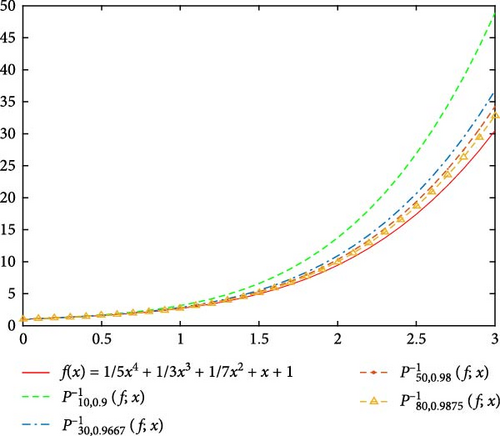
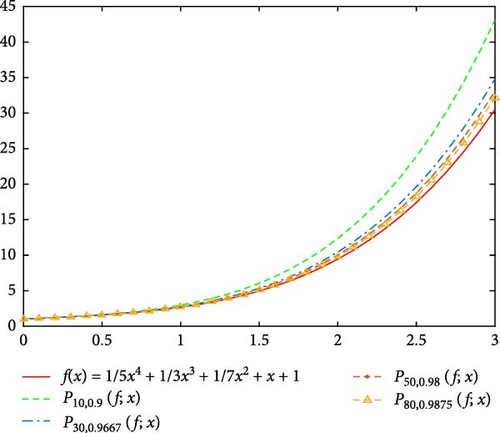
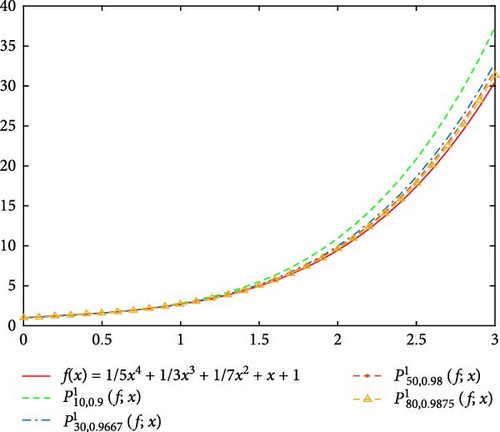
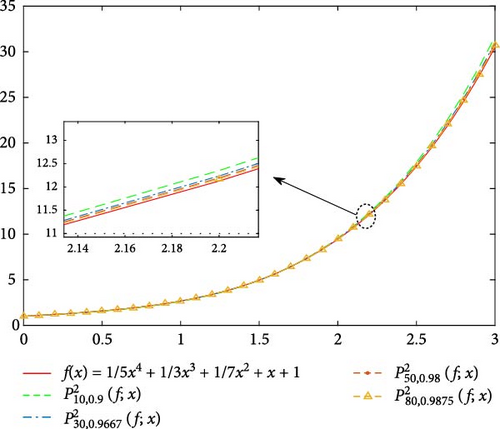
Moreover, in Figure 5, we compare the new modification of q-Post–Widder operators in Equation (13) with q-Post–Widder operators in Equation (5) and the classical Post–Widder operators in Equation (4) for the values n = 50, q = 0.98, and α = −1, 1, 2. Also, we illustrate its error of the approximation process in Figure 6. It is obvious that introduced operator in Equation (13) for α = 1 and α = 2 has better approximation than operators in Equations (4) and (5).
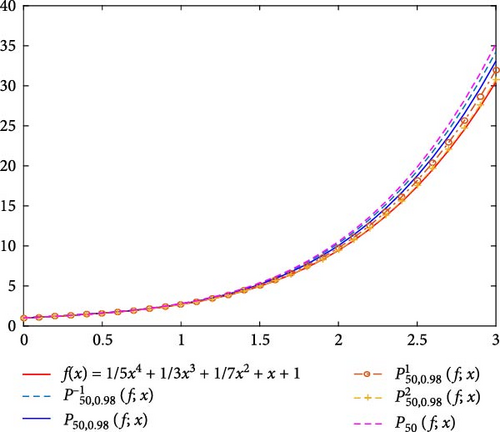
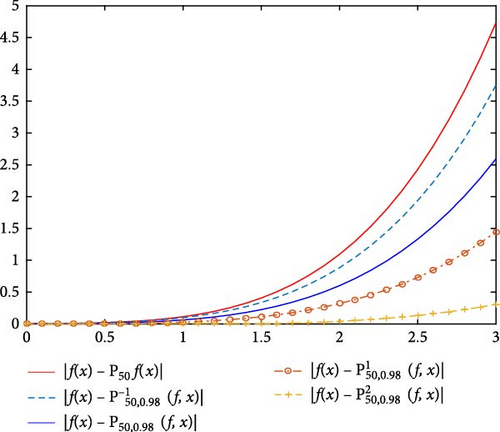
7. Conclusion
The new modification of q-Post–Widder operators based on the parameter α is established. The parameter α gives us more modeling flexibility. In this paper, we derive Korovkin type convergence theorem, rate of convergence, pointwise estimates, weighted approximation, and Voronovksya type theorems. Moreover, we provide some numerical experiments to verify the theoretical results.
Disclosure
It is confirmed that manuscript is not under review or published elsewhere.
Conflicts of Interest
The author declares that there is no conflicts of interest.
Acknowledgments
Qiu Lin was supported by the Research Fund for Yancheng Teachers University under 204040026.
Open Research
Data Availability
Data availability is not applicable to this article as no new data were created or analyzed in this study.



